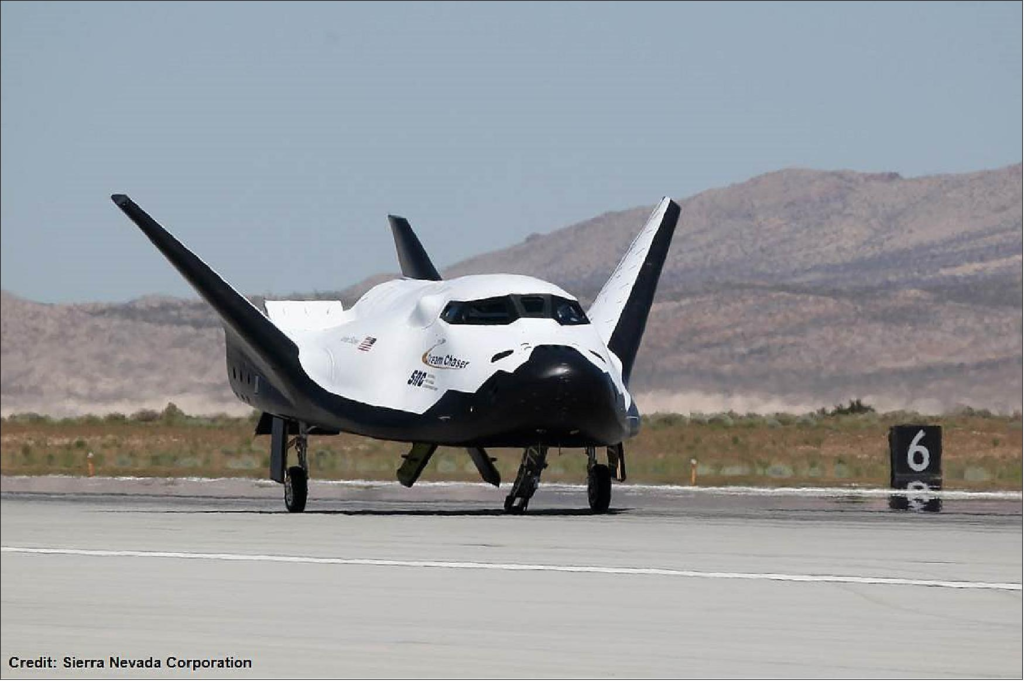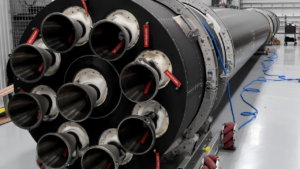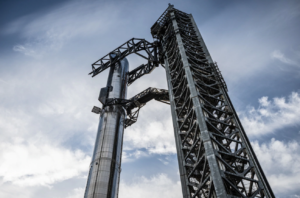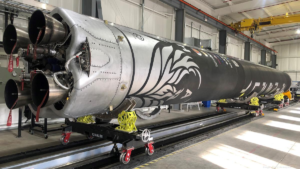
Dream Chaser Tenacity’s First Ever Launch Has Been Pushed Back
Dream Chaser is a next generation spaceplane that has been under development for over a decade. Its first official test article named Tenacity has recently been going through some final construction and testing in preparation for the maiden flight which was scheduled to happen only months from now around August. Unfortunately, a few things just went wrong that will push this launch back quite a bit.
Specifically, earlier this week NASA updated its internal schedule to show that Sierra Space’s Dream Chaser spacecraft will now berth to the International Space Station no earlier than December 17, 2023. For a while now it was known that Sierra Space was targeting the third quarter of this year or right around August for this mission.
Just to make matters worse, Vulcan which is already a decent bit behind schedule, is now running into anomalies prior to its first flight. This is a big deal because Dream Chaser will use this rocket as its ride to the ISS. Here I will go more in-depth into the recent delay, problems with ULA’s Vulcan, what to expect in the coming months, and more.
New Delays

Just in the last few days, it was reported that Dream Chaser’s launch slipped to late this year in December. The most recent update on Tenacity we received was months ago in January when the company said in a quote, “The first Dream Chaser, Tenacity, is nearing completion and will subsequently ship to NASA’s Neil A. Armstrong Test Facility in Cleveland, Ohio, for final space environmental testing ahead of its first mission to the ISS later this year.” Since then, we haven’t heard anything about Tenacity’s physical progress or if the spaceplane is in the process of being tested. The recent reports from media however are not the most promising.
The delay to December suggests that there is still quite a bit of work left. This is almost half a year later than they were originally indenting for. Not only does this cause issues for Dream Chaser and Sierra Space, but it also makes things with United Launch Alliance a lot more complicated.
As I speak, ULA is in the process of testing the Vulcan Centaur on the pad in preparation for its maiden flight scheduled to happen on May 4th. However, for days now the company has been dealing with and reporting issues surrounding the Centaur upper stage. Yesterday ULA CEO Tory Bruno tweeted saying, “Keeping you posted: During Qual testing of Centaur V structural article at MSFC, the hardware experienced an anomaly. This is is why we thoroughly & rigorously exercise every possible condition on the ground before flight. Investigation is underway. Vulcan will fly when complete.” This is not good especially considering the fact that this maiden flight is already been delayed for months. Late last year, ULA expected to ship the completed vehicle to the launch site in November. In addition, they pointed out that once at the Cape, Vulcan would undergo a final series of tests to verify its readiness for flight consisting of multiple tanking tests and a wet dress rehearsal, culminating in flight readiness firing in December, which will be the final step prior to launch. It’s now April of the next year and it looks like they are still a ways away from the final static fire that was meant to be completed in December.
At this point, both Dream Chaser and its launch vehicle are facing different challenges and delays making it hard to determine when the two can successfully work together for Tenacity’s launch. One of the aspects of Dream Chaser that we know took a long time was the installation of each heat shield tile. Dream Chaser uses thousands of thermal tiles across its body to protect against the heat of reentry. Unfortunately, these unique individual tiles take some time for installation. Over the past few months, this is what the company has been working on. With few updates from Sierra Space, it’s unclear how this process among other are going.
Looking at this system, Sierra Space is quoted saying, “SNC engineers have been able to update the TPS tiles from what was used during NASA’s shuttle program with more innovation, better technology, and utilizing lessons learned. They use more modern manufacturing techniques to increase strength and reduce cost. Another difference between the tiles is Dream Chaser tiles are about 10 inches by 10 inches, while those on the shuttle were six inches by six inches. Dream Chaser tiles are stronger and lighter weight than those used during the shuttle program and meet all Micro-Meteroid Orbital Debris (MMOD) requirements to ensure safe entry, descent, and runway landings for crewed or cargo missions.
First Dream Chaser Mission

The first Dream Chaser mission is expected to be very special for a few reasons. The cargo version of the SNC Dream Chaser is called the Dream Chaser Cargo System and after development completes, will fly resupply flights to the ISS under NASA’s Commercial Resupply Services-2 program. Featuring an expendable cargo module mounting solar panels, the spacecraft will be capable of returning 1,750 kg (3,860 lb) to Earth while undergoing maximum re-entry forces of 1.5G. However, in order to meet CRS-2 guidelines, the cargo Dream Chaser will have folding wings and fit within a 5 m diameter payload fairing, in contrast to the Crewed Dream Chaser, which is intended to launch without a fairing. The ability to fit into a payload fairing allows the cargo version to launch on any sufficiently capable vehicle.
On August 14, 2019, it was announced that all six Dream Chaser CRS-2 flights will be carried into orbit by ULA’s Vulcan launch vehicle, with the first Dream Chaser flight being the second Vulcan flight in late 2021. However, on February 9, 2022, Ken Shields, Sierra Space’s Director of Commercial Market Development announced that the first flight would be pushed to January 2023. The launch has been then furtherly delayed, and it’s scheduled for late this year if everything goes according to plan.
It’s also important to point out that the latest delay of both Vulcan and Dream Chaser will likely cause some concern for NASA, as it means that beginning this summer the US segment of the space station will be reliant on the Falcon 9 rocket alone for cargo supply missions. This is because in addition to ferrying SpaceX’s Cargo Dragon to the station, Northrop Grumman’s cargo-carrying Cygnus will start launching on the Falcon 9 as well. NASA ideally doesn’t want to put all of its eggs in one basket. Dream Chaser was expected to begin these cargo missions this summer but now it might not even launch this year.
Designed for high reusability, Dream Chaser is trying to reduce overall cost, providing quick turnarounds between missions. The ability to liftoff on top of multiple launch vehicles and land at a wide variety of runways makes Dream Chaser a flexible option for reliable transportation. After leaving the space station, the Dream Chaser Cargo System also offers disposal services via the Shooting Star transport vehicle. Once separated from Dream Chaser, Shooting Star burns up safely in Earth’s atmosphere. Years ago, Dream Chaser was originally designed as a crewed spaceplane, in part under NASA’s Commercial Crew Program, capable of carrying up to seven astronauts to and from the space station and other low Earth orbit (LEO) destinations. The crewed version of Dream Chaser is approximately 85% common to the cargo system, limiting primary changes to windows, environmental control, and life support systems. In addition, an integral main propulsion system is available for abort capability and major orbital maneuvers. To put size in perspective, Dream Chaser is 30 feet, or 9 meters long—roughly ¼ the total length of the space shuttle orbiters—and can carry up to seven crew members.
As partially mentioned prior, one of the possible aspects of Dream Chaser responsible for the recent delays could be its heat shield. Back in 2015, Sierra Nevada Corporation (the parent company of Sierra Space) successfully completed several significant Thermal Protection System (TPS) material development tests for its Dream Chaser spacecraft. The TPS tests were completed at NASA’s Ames Research Center and Johnson Space Center under reimbursable Space Act Agreements (SAA). At the time, the corporate vice president of SNC’s Space Systems commented, “Safety of crew and cargo is most important to our team as we continue to mature the spacecraft design. For several years, we have worked collaboratively with Johnson and Ames, leveraging their existing infrastructure, materials, and expertise to mature and customize the TPS for our unique spacecraft. Our TPS is lighter, stronger, and more efficient than previous generations. We have met or exceeded all mission requirements. We are now prepared to enter the Critical Design Review phase for this system.”
As far as the tests themselves, over 100 arc jet cycles and radiant heat tests were completed at Johnson’s Radiant Heat Test Facility (RHTF) and Ames’ Aerodynamic Heating Facility (AHF). RHTF provided results supporting the thermal characterization of the developmental TPS materials. The test data was then used for thermal modeling, analysis, and TPS sizing. The Ames AHF arc jet tests were performed as a second phase in the development testing to gauge the material performance in environments simulating Dream Chaser flight conditions. Valuable arc jet test results supported SNC’s certification of the manufacturing capability of a high-temperature material called Toughened Uni-Piece Fibrous Reinforced Oxidation-Resistant Composite TUFROC. TUFROC will be used on the high-temperature nose and wing leading edges of the Dream Chaser spacecraft. Something we will have to wait to see in action as delays continue.
Conclusion
Dream Chaser and its launch vehicle Vulcan have both run into some issues. Vulcan’s upper stage has experienced an anomaly while Dream Chaser’s first mission was pushed back to no earlier than December. We will have to wait and see how it progresses and the impact it has on the space industry.



